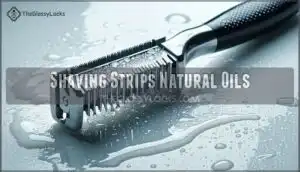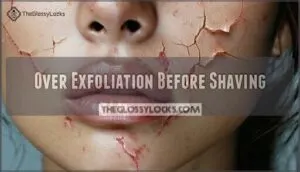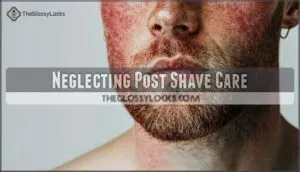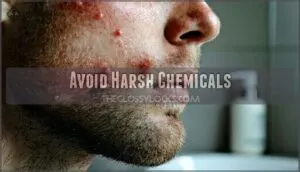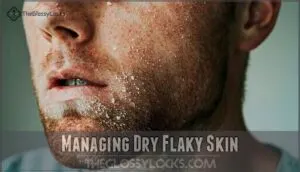This site is supported by our readers. We may earn a commission, at no cost to you, if you purchase through links.
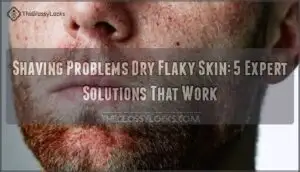 Shaving problems dry flaky skin plague countless men who unknowingly strip away their skin’s protective barrier with every stroke.
Shaving problems dry flaky skin plague countless men who unknowingly strip away their skin’s protective barrier with every stroke.
Your razor removes natural oils along with whiskers, leaving your face tight and irritated. This happens when you use dull blades, harsh products, or skip proper prep work.
The mechanical scraping combined with alcohol-based aftershaves creates a perfect storm for moisture loss. You’re basically giving your face a sandpaper treatment twice daily.
The fix isn’t complicated—it’s about changing your approach to pre-shave prep, product selection, and post-shave care. Smart adjustments transform your routine from skin torture into smooth sailing.
Table Of Contents
- Key Takeaways
- Causes of Dry Skin
- Dryness Vs Tightness
- Preventing Dry Skin
- Soothing Dry Skin
- Managing Dry Flaky Skin
- Frequently Asked Questions (FAQs)
- What are the side effects of dry shaving?
- What happens if you have tight skin after shaving?
- How to deal with dryness after shaving?
- Should you shave over irritated skin?
- Should I Shave dry or wet?
- Is dry skin after shaving a problem?
- Why is my skin dry and flaky after shaving?
- How to cure flaky pubes after shaving?
- Is vaseline good for shaving rash?
- What is the best method for dry shaving skin?
- Conclusion
Key Takeaways
- You’re stripping your skin’s natural protective oils when you shave, leaving it vulnerable to dryness and irritation – fix this by using pre-shave oils and moisturizing immediately after shaving
- Dull blades force you to press harder and make multiple passes, creating micro-tears that worsen flakiness – replace your razor every 5-7 shaves to maintain sharp cutting edges
- Harsh chemicals in shaving products containing alcohol, sulfates, and fragrances damage your moisture barrier – switch to gentle, fragrance-free formulas designed for sensitive skin
- You can prevent post-shave dryness by preparing properly with warm water soaks, using hydrating shaving creams, and applying cooling aftershave products within three minutes of finishing
Causes of Dry Skin
You’re dealing with dry, flaky skin after shaving because the process strips away your skin’s natural protective oils and disrupts its moisture barrier.
When you combine razor friction with harsh shaving products, dull blades, and skipped aftercare, you create the perfect storm for irritated, dehydrated skin that feels tight and looks flaky, leading to a condition that is both uncomfortable and visually unappealing due to the natural protective oils being stripped away.
Shaving Strips Natural Oils
When you shave, you’re not just removing hair—you’re also scraping away your skin’s natural oils.
This sebum loss weakens your lipid barrier, making it harder for your skin to hold onto hydration.
That’s why dry skin after shaving is so common, and why oil replenishment with post-shave oils helps restore hydration retention and fights shaving irritation, keeping dry skin at bay.
Harsh Chemicals in Shaving Products
Losing natural oils is only half the battle—harsh chemicals in shaving products can make dry skin after shaving much worse.
Chemical irritants, high alcohol content, and strong fragrances can trigger shaving irritation or even Fragrance Sensitivity.
Shaving products with sulfates can cause scalp and skin irritation.
Watch out for these common culprits:
- Paraben concerns
- Sulfate effects
- Artificial fragrances
- High alcohol content
- Dyes and preservatives
Dull Razors Increase Irritation
Ever tried mowing a lawn with a butter knife? That’s what using dull blades feels like on your skin.
Poor blade sharpness means you’ll press harder, upping irritation severity and risking razor burn. This rough shaving technique can cause skin damage, especially when shaving dry skin.
Always swap out your razor before it starts feeling like sandpaper. Your face will thank you, as maintaining sharp blades is crucial for preventing irritation and ensuring a smooth shave, which helps avoid skin damage.
Over Exfoliation Before Shaving
Too much exfoliation before shaving is like scrubbing a wall before painting—overdoing it weakens the surface.
If you exfoliate dry skin too often or use harsh scrubs, your skin barrier suffers.
Pay attention to exfoliation timing, frequency, and product ingredients, as chemical vs. physical exfoliation matters—gentle is better.
Smart preshave exfoliation keeps your skin smooth, not raw and irritated.
Neglecting Post Shave Care
Skipping your aftershave routine leaves your skin vulnerable and dry.
Without proper postshave care, you’re missing essential steps that replenish moisture and calm irritation.
Moisturizer importance can’t be overstated—it locks in hydration after shaving strips away natural oils.
Cooling products with soothing aftershave ingredients help reduce inflammation, while natural remedies and hydration serums restore your skin’s barrier for ideal postshave dryness prevention, which involves using products with soothing aftershave ingredients.
Dryness Vs Tightness
You might feel like your skin is pulling after shaving, but there’s a difference between dryness and tightness that affects how you should treat it.
Dryness means your skin lacks moisture and natural oils, while tightness is that uncomfortable pulling sensation from reduced flexibility in your skin cells, related to the concept of tightness.
Lack of Moisture
Dry skin after shaving happens when your skin lacks moisture.
This isn’t just about surface dryness—it’s about your skin’s ability to hold onto water.
When you shave, you’re removing natural oils that keep moisture locked in.
Your skin’s hydration depends on this delicate balance.
Without proper moisturizing after shaving, you’ll notice that parched feeling that makes you want to scratch.
| Moisture Factor | What Happens | Your Skin’s Response |
|---|---|---|
| Oil Depletion | Natural protective barrier gets stripped | Increased water loss through skin surface |
| Barrier Function | Skin’s defense system becomes compromised | Hydration escapes more easily |
| Product Ingredients | Harsh chemicals remove essential moisture | Skin feels tight and looks flaky |
Reduced Skin Flexibility
Tightness hits differently than dryness.
When your skin loses elasticity after shaving, it feels stretched and uncomfortable.
This skin tightness stems from collagen production disruption and hydration levels dropping.
Sharp product ingredients can worsen this condition, making your face feel like it’s shrinking.
| Flexibility Factor | What You Feel |
|---|---|
| Normal Elasticity | Skin bounces back smoothly |
| Reduced Flexibility | Tight, stretched sensation |
| Severe Loss | Uncomfortable pulling feeling |
Insufficient Natural Oils
Your skin’s oil depletion becomes the root of post-shave discomfort.
Sebum loss and lipid removal strip away your natural protective barrier, making skin hydration nearly impossible.
This barrier damage triggers excessive water loss, leaving you with that familiar tight, uncomfortable feeling.
| Oil Loss Type | Impact on Skin | Recovery Time |
|---|---|---|
| Sebum Depletion | Immediate dryness | 2-4 hours |
| Lipid Removal | Barrier breakdown | 6-12 hours |
| Natural Oil Loss | Flaky skin appearance | 12-24 hours |
Loss of Elasticity
Everyone experiences collagen breakdown and elastin damage after shaving, causing skin sagging and reduced firmness.
These aging effects worsen when your skin dryness isn’t addressed properly. Loss of skin elasticity makes your face feel tight, while poor skin hydration accelerates the aging process after regular shaving routines.
Fortunately, limiting sun exposure can help mitigate these effects.
| Elasticity Factor | Before Shaving | After Shaving |
|---|---|---|
| Collagen levels | Normal production | Temporarily disrupted |
| Skin bounce-back | Quick recovery | Delayed response |
| Firmness quality | Natural tautness | Loose, saggy feel |
| Hydration status | Balanced moisture | Depleted reserves |
| Overall texture | Smooth appearance | Rough, aged look |
Preventing Dry Skin
You can prevent the dry, flaky aftermath of shaving with the right preparation and technique.
Smart pre-shave habits and quality products make all the difference between irritated skin and smooth results.
Cleanse and Exfoliate Before Shaving
Proper pre-shave cleansing sets the foundation for smooth, irritation-free shaving.
You’ll want to remove dirt, oil, and dead skin cells that can clog your razor and cause friction against sensitive skin.
Here’s your pre-shave routine:
- Cleanse with lukewarm water – Opens pores without over-drying your skin
- Gentle exfoliation 24 hours before – Use chemical exfoliants rather than harsh scrubs
- Soak skin for 10 minutes – Softens hair and prepares skin for easy cutting
Use Gentle Razor
Your razor’s sharpness makes all the difference between smooth sailing and a skin disaster.
Dull blades tug at hair instead of cutting cleanly, creating micro-tears that lead to razor burn and ingrown hairs.
Sharp razor blades require less pressure, reducing irritation on sensitive areas.
Consider using razors for sensitive skin to minimize irritation.
Replace cartridges every 5-7 shaves and maintain proper razor maintenance by rinsing between strokes for ideal shaving technique.
Choose Sensitive Skin Products
When choosing products for sensitive skin, fragrance-free formulas become your best friend.
Look for hypoallergenic options specifically designed for dry skin and sensitive skin types. Always check ingredient lists—avoid alcohol-based shaving creams that strip moisture.
Try patch testing new products on your wrist first. Reading product reviews from fellow sensitive-skin sufferers helps you find gentle, effective skin care solutions.
Consider using specialized skincare options for ideal results, and remember to choose products that are suitable for your skin type to achieve the best outcome with sensitive skin.
Avoid Harsh Chemicals
Check your skincare labels like you’re reading a restaurant menu with allergies.
Alcohol content in aftershaves can strip away moisture, leaving your sensitive skin feeling like sandpaper.
Identify irritants such as fragrances and parabens that trigger reactions.
Look for sulfate alternatives in cleansers, as these harsh detergents worsen dry skin.
Your face deserves gentle, fragrance-free products that won’t sabotage your shaving routine.
Incorporate Infrared Sauna
Heat therapy transforms your skin care routine by boosting natural hydration and repair.
Infrared sauna sessions increase blood flow, delivering nutrients that combat post-shave dryness while stimulating collagen production for stronger skin barriers.
Sunlighten saunas can help maximize detoxification with Solocarbon heating technology.
- Sauna Skin Hydration: Deep sweating clears pore-blocking residue from shaving creams
- Sauna Collagen Boost: Heat stimulates fibroblasts to reduce inflammation and micro-cuts
- Post-Shave Sauna: Regular sessions strengthen skin resilience against razor irritation
Soothing Dry Skin
When your skin feels tight and irritated after shaving, you need targeted relief that works fast.
The right soothing techniques can transform post-shave discomfort into smooth, hydrated skin that feels comfortable all day.
Moisturize Immediately After Shaving
Right after your final razor stroke, your skin’s crying out for moisture like a desert begging for rain. Don’t wait – apply moisturizer within three minutes to lock in hydration and prevent that tight, uncomfortable feeling.
Your skin thirsts for moisture the moment that razor blade finishes its work.
| Timing | Product Type | Application Method |
|---|---|---|
| Within 3 minutes | Fragrance-free cream | Gentle patting motions |
| Immediately post-rinse | Hyaluronic acid serum | Light pressing technique |
| Before towel drying | Ceramide moisturizer | Upward circular strokes |
| On damp skin | Natural oils blend | Smooth spreading motion |
The secret’s in the cream consistency – thicker formulas create better barriers for locking moisture. Your application techniques matter too; gentle patting helps product absorption without irritating freshly shaved skin. These hydration benefits extend beyond immediate comfort, supporting long-term skin health and reducing dry skin after shaving episodes that plague many people.
Use Cooling Aftershave Products
After shaving leaves your skin feeling raw, cooling aftershave products offer instant relief.
Look for formulas containing aloe benefits and menthol effects – these cooling ingredients reduce skin irritation and provide soothing comfort.
When selecting cooling products, choose alcohol-free options to prevent further drying. Explore options for soothing relief aftershave for superior results.
Proper application techniques matter: gently pat aftershave onto clean skin rather than rubbing vigorously, allowing the moisturizing properties to calm razor burn effectively.
Apply Natural Remedies
While cooling aftershave helps temporarily, nature’s pharmacy offers powerful long-term healing.
Aloe vera delivers deep hydration and reduces inflammation with its vitamins and antioxidants. Aloe vera is also known to help soothe post-shaving irritation.
Raw honey acts as a natural humectant, drawing moisture into skin while gently exfoliating dead cells. Coconut oil’s lauric acid soothes irritation and reinforces your skin barrier.
Hydrocortisone cream provides quick anti-inflammatory relief for stubborn redness, offering a powerful solution with deep hydration and natural ingredients that help with inflammation.
Use Gentle Hydrating Products
After experiencing the frustration of dry skin after shaving, you’ll want products that baby your complexion back to health.
Gentle, hydrating products become your skin’s best friend when razor burn strikes.
Choose these essentials for post-shave relief:
- Soap-free cleansers with hydrating ingredients like ceramides
- Alcohol-free formulas that won’t strip sensitive skin further
- Natural oils (jojoba, argan) for deep moisture restoration
- Hydrating shaving cream with glycerin or aloe vera
- Fragrance-free moisturizers designed for sensitive skin types
Your skin deserves TLC after each shave—these gentle products deliver exactly that without causing additional irritation.
Consider products that maintain healthy skin pH for ideal results.
Apply Hydrating Serums
Beyond gentle products, hydrating serums pack a powerful punch for dry skin after shaving.
Hyaluronic Acid serums draw moisture like magnets, while Ceramide Boost formulas repair your skin barrier.
Master Serum Application by patting—never rubbing—onto damp skin.
Layering Serums works best when you apply thinnest to thickest consistency.
This Targeted Hydration approach transforms irritated skin into smooth comfort.
| Serum Type | Key Benefits | Application Tips |
|---|---|---|
| Hyaluronic Acid | Holds 1000x its weight in water | Apply to damp skin for maximum absorption |
| Ceramide Complex | Repairs damaged skin barrier | Use morning and evening after cleansing |
| Niacinamide | Reduces inflammation and redness | Start with 2-3 times weekly to build tolerance |
| Peptide Serums | Promotes collagen production | Layer under heavier moisturizers for best results |
| Vitamin E Blend | Antioxidant protection and healing | Perfect for post-shave application to calm irritation |
Managing Dry Flaky Skin
When dry, flaky skin persists despite your best shaving efforts, you’ll need targeted strategies that address the root causes rather than just treating symptoms.
These five expert-backed approaches tackle stubborn flakes by adjusting your routine, environment, and product choices to restore your skin’s natural balance and smooth texture.
They help to restore your skin’s natural balance and smooth texture.
Adjust Shaving Frequency
Beyond soothing treatments, you’ll find that adjusting your shaving frequency can substantially reduce dry, flaky skin issues.
Your skin condition and seasonal changes affect how often you should shave.
Consider these timing adjustments:
- Skip daily shaving when experiencing razor burn or skin sensitivity
- Reduce frequency during winter months when skin naturally becomes drier
- Allow 48-72 hours between shaves for sensitive areas to recover
- Match shaving schedule to your hair growth patterns
- Increase intervals during flare-ups of dry skin conditions
Smart shaving tips include monitoring your skin’s response and adapting accordingly, which can help with skin sensitivity and dry skin conditions.
Use Humidifiers
Dry indoor air steals moisture from your skin, making post-shave flakiness worse. Installing humidifiers in your bedroom and bathroom creates an environment that supports natural skin hydration throughout the day.
| Humidity Benefits | Ideal Levels |
|---|---|
| Prevents moisture loss | 30-50% humidity |
| Reduces skin irritation | Monitor with hygrometer |
| Supports barrier function | Adjust seasonally |
Cool-mist humidifiers work best for skin health, while warm-mist types can harbor bacteria. Position units away from electronics and clean weekly to prevent mold growth and ensure optimal performance with natural skin hydration.
Exfoliate Strategically
Smart exfoliation timing separates skincare pros from amateurs when tackling dry skin shaving challenges.
You’ll want to exfoliate 24 hours before shaving using gentle exfoliants like AHAs rather than harsh scrubs for effective pre-shave prep.
- Chemical vs. Physical: Choose gentle chemical exfoliants over abrasive scrubs that create micro-tears
- Timing matters: Exfoliate one day before shaving to avoid irritating freshly sensitized skin
- Dead skin removal: Clear away buildup that clogs razors and causes uneven shaves
- Avoid over-exfoliation: Skip daily scrubbing that strips your skin’s protective barrier completely
Use Hydrating Shaving Creams
Your skin needs the right cream ingredients to combat dry skin after shaving.
Choose hydrating shaving products with glycerin, aloe vera, or shea butter for sensitive formulations. These cream alternatives provide lathering benefits while protecting your moisture barrier.
| Cream Ingredients | Application Technique | Sensitive Formulations |
|---|---|---|
| Glycerin & Hyaluronic Acid | Apply to damp skin | Fragrance-free options |
| Aloe Vera & Shea Butter | Use circular motions | Alcohol-free formulas |
| Coconut Oil & Ceramides | Let sit 2-3 minutes | Dermatologist-tested |
| Natural Plant Extracts | Rinse with cool water | Hypoallergenic blends |
| Vitamin E & Panthenol | Pat dry gently | pH-balanced solutions |
Consult Dermatologist for Aggressive Treatments
Professional intervention becomes essential when persistent irritation defies conventional skin care solutions.
Dermatologists can transform your battle with severe dryness through targeted treatment options:
- Prescription topicals – Corticosteroid creams control inflammation and flakiness
- Chemical peels – Remove stubborn dead skin layers professionally
- Advanced barrier repair – Specialized ceramide treatments restore skin function
When to consult: dry skin that worsens despite proper care warrants professional assessment for underlying skin problems.
Consider using fragrance-free formulas to minimize irritation.
Frequently Asked Questions (FAQs)
What are the side effects of dry shaving?
Shaving without proper preparation strips your skin’s natural oils and protective barrier, causing irritation, razor burn, cuts, and uncomfortable tightness that can last for days afterward.
What happens if you have tight skin after shaving?
Your skin feels like it’s been shrink-wrapped after shaving because you’ve stripped away natural oils and damaged the protective barrier.
This tightness signals dehydration and irritation, making your face uncomfortable and potentially leading to flakiness if not addressed properly.
How to deal with dryness after shaving?
Immediately apply a fragrance-free moisturizer after patting your skin dry. Use gentle, hydrating products and consider cooling aloe vera gel to soothe irritation and restore your skin’s moisture barrier.
Should you shave over irritated skin?
No, you shouldn’t shave over irritated skin. Give your skin time to heal first, as shaving inflamed areas worsens irritation and can lead to cuts or infection.
Should I Shave dry or wet?
Always shave wet, never dry. Wet shaving reduces friction by 70%, prevents razor burn, and protects your skin’s moisture barrier from damage and irritation.
Is dry skin after shaving a problem?
Like walking on thin ice, dry skin after shaving isn’t just cosmetic—it’s your body signaling barrier damage.
You’re stripping natural oils and creating micro-injuries that increase water loss, leading to irritation and discomfort that needs proper care.
Why is my skin dry and flaky after shaving?
Your skin becomes dry and flaky after shaving because the razor strips away natural oils and scrapes off protective skin cells.
Disrupting your skin’s moisture barrier and allowing water to escape.
How to cure flaky pubes after shaving?
Think of your skin as delicate petals after a storm—it needs gentle care.
Moisturize immediately with fragrance-free lotion, exfoliate gently beforehand, and use sharp razors with proper lubrication to prevent future flakiness.
Is vaseline good for shaving rash?
Vaseline can help soothe shaving rash by creating a protective barrier and locking in moisture.
However, it’s thick and may clog pores, so use sparingly or consider lighter alternatives like aloe vera.
What is the best method for dry shaving skin?
Treating your skin like parched earth that’s thirsty for water, never dry shave without proper preparation.
You’ll strip away natural oils and create irritation.
Instead, always wet your skin with warm water, apply pre-shave oil or cream for lubrication, and moisturize immediately afterward.
Conclusion
Transforming your morning routine from facial torture chamber to smooth operator doesn’t require a complete overhaul of your grooming arsenal.
By addressing shaving problems dry flaky skin through proper pre-shave prep, quality products, and consistent aftercare, you’ll notice dramatic improvements within days.
Your skin will thank you for ditching harsh chemicals, using sharp blades, and never skipping moisturizer again.
- https://www.jnhlifestyles.com/blog/dry-skin-after-shaving-maybe-this-can-help
- https://www.menshealth.com/uk/style/grooming/a63915755/is-dry-shaving-harmful/
- https://www.razoremporium.com/blog/facts-vs-myths-the-impact-of-shaving-on-your-skin/
- https://www.mayoclinic.org/diseases-conditions/dry-skin/symptoms-causes/syc-20353885
- https://www.medicalnewstoday.com/articles/318235

